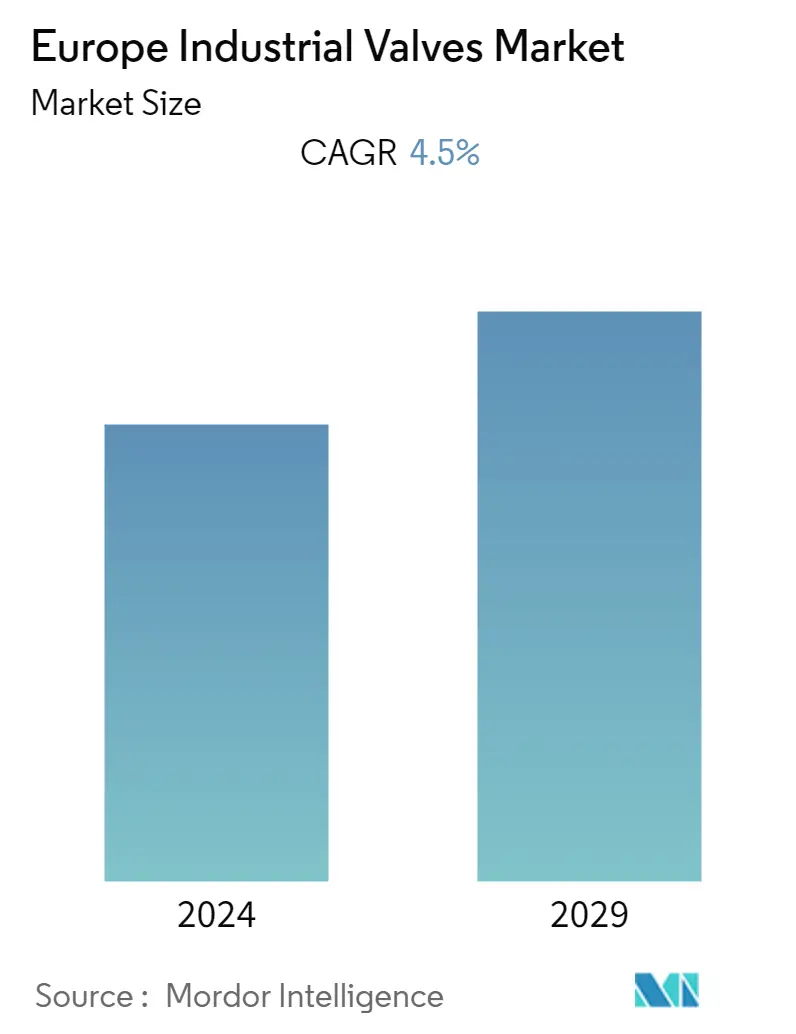Market Size of Europe Industrial Valves Industry

| Study Period | 2019 - 2029 |
| Base Year For Estimation | 2023 |
| Forecast Data Period | 2024 - 2029 |
| Historical Data Period | 2019 - 2022 |
| CAGR | 4.50 % |
| Market Concentration | Low |
Major Players
*Disclaimer: Major Players sorted in no particular order |
Need a report that reflects how COVID-19 has impacted this market and its growth?
Europe Industrial Valves Market Analysis
The European industrial valve market is projected to grow at a CAGR of 4.5% during the forecast period. The major factors driving the market are rising population levels in countries and increasing oil and gas exploration. The increased consumption of oil leads to the expansion of oil refineries. As a result of the expansion of oil refineries, there is a greater demand for valves that can withstand high pressure while minimizing operational waste. This factor is expected to propel the market forward.
- Industrial valves are important in the increasingly complex industrial and working world. Pipelines and hose pipes are required for the transportation of gas, liquids, and freely flowing solids in nearly every industry, including the production of natural gas and crude oil, as well as in the fields of medicine and water treatment.
- European countries' technological development has shaped creative answers that can increase process plants' efficiency by streamlining their operations. Valve suppliers must keep creating products and procedures that meet these new challenges as industry standards change and evolve.
- Furthermore, the COVID-19 outbreak had a significant negative impact on European nations, notably the United Kingdom. Due to falling oil prices in the first quarter of 2020, the economies of several countries in the region suffered, and business activity in the oil and gas sector decreased. Many European nations have partially closed their borders as part of drastic measures to restrict imports, exports, and the movement of goods. Such factors slowed down the growth of the market.
- However, the United Kingdom stood out favorably among the most significant customer nations, according to VDMA Valves Association. Industrial Valves exports to the United Kingdom increased by 15.7% to EUR 100 million (USD 104.89 million ) in H1 2022 from H1 2021. The number of shipments from Switzerland increased significantly by 14.3%. The number of exports was EUR 85.4 million (USD 89.57 million). Additionally, exports to France increased by 4.4%. With a volume of EUR 138.7 million (USD 145.48 million) for industrial Valves in H1 2022 compared to H1 2021, the nation maintains its third-place ranking among the most significant sales markets.
- Additionally, the demand for energy and the E&P (exploration and production) of oil and gas activities are increasing as many nations start to reopen their industries, fostering the expansion of the European industrial valve market. With businesses investing in boosting productivity and efficiency, it is anticipated that by the end of 2022, demand for industrial valves will have recovered due to the increase in vaccination campaigns.
- Additionally, the COVID-19 outbreak has caused a global economic crisis. The pandemic drastically reduced oil prices, which negatively impacted the oil and gas sector and resulted in low demand for industrial valves. There is less scope for storage space for extracted oil among major oil producers, and demand is falling. According to BP's Statistical Review of World Energy 2021, improvements in road mobility resulted in a 13% (3.1 Mb/d) decrease in gasoline demand.
